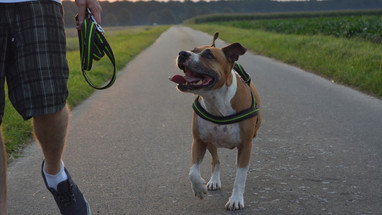Teaching Off-Leash Walking
Q: How do I train my dog to walk off the leash?
A: The key to training your dog to walk well off the leash is to first teach him to walk properly on the leash. A prior Loving Pets Newsletter article explains in detail how teach your dog to walk on-leash without pulling. Follow all the guidelines explained in the article. After following the procedures in the referenced article, when you have gone several weeks without experiencing pulling or a tight leash and if you believe your dog is emotionally mature enough to act responsibly without a leash, you can venture into off-leash training.
When commencing off-leash training:
- Start in an enclosed low-distraction environment, such as a fenced backyard or ballfield,
- Train at a time of day when you are unlikely to encounter other people or dogs,
- Use high-stimulation food to lure your dog into heel position, and
- Use a dropped leash, long line, or light line as a response blocking tool should your dog elect to move out of position or bolt.
Hold the food in your left hand, keep extra food in your left pocked, command Walk or Heel, then progress forward. If your dog remains in heel position, praise him/her lavishly. If your dog remains in heel position and walks with upward focused attention, praise and reward periodically with the food. If your dog moves out of position or bolts, quickly step on the dragged leash, long line, or light line to prevent the infraction. Then, return to praising your dog once he/she returns to heel position. Do not admonish verbally should your dog make an error. Instead, your sole “rebuke” should be the silent communication that occurs when you step on the dropped leash or light line.
Once your dog is highly reliable in a low distraction environment, you can gradually progress to incrementally more difficult environments. Once he/she is highly reliable in the high distraction environments, whereby you haven’t needed to step on the dragged line for several weeks, then you can examine your dog’s off-leash heeling without the line. When removing the dragged leash or light line, we recommend first examining your dog’s true off-leash performance in a safe, low-distraction environment.
Whenever conducting off-leash training or off-leash handling understand that you are increasing risks to your dog’s safety and to your wallet, as you may be in violation of local leash law ordinances. Nevertheless, off-leash training can help you to better enjoy companion activities, such as camping, hiking, or trail running. Moreover, off-leash training can be a valuable preparatory tool should you ever encounter an emergency situation where you need to handle your dog and no leash is immediately available, such as if you need to depart your home immediately during a fire or if you need to call your dog and walk him home after he has escaped an open gate or a damaged fence.
© Copyright Mark Spivak and Comprehensive Pet Therapy, Inc., March 2011, All rights reserved.



